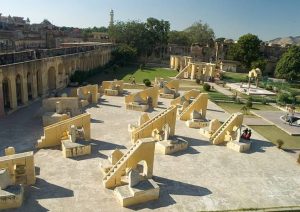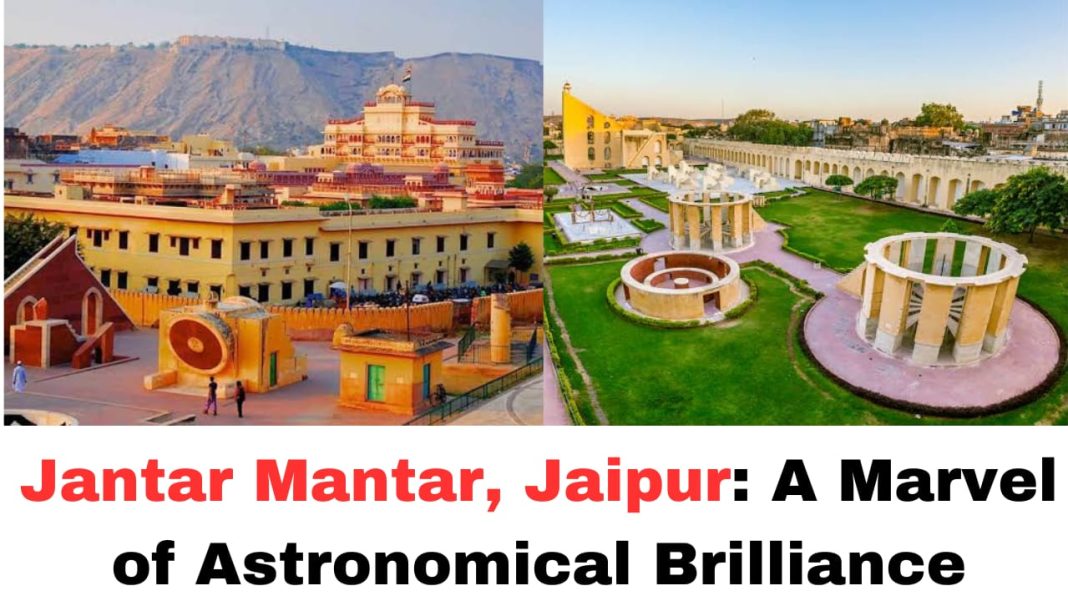Digital News Guru Rajasthan Desk:
Jantar Mantar
Nestled in the heart of Jaipur, Rajasthan, the Jantar Mantar stands as a testament to India’s scientific and architectural ingenuity during the early 18th century. This UNESCO World Heritage Site is a celestial observatory, embodying the grandeur of ancient astronomical science. Built by Maharaja Sawai Jai Singh II between 1727 and 1734, Jantar Mantar serves as a window into a bygone era when the heavens were meticulously studied to understand time, space, and celestial movements. Its significance lies not only in its monumental architecture but also in its scientific purpose, which continues to intrigue historians, astronomers, and tourists alike.
Historical Background
Maharaja Sawai Jai Singh II, the visionary behind Jantar Mantar, was a polymath deeply interested in astronomy, mathematics, and architecture. Fascinated by celestial phenomena, he built five such observatories across India, with the one in Jaipur being the largest and most well-preserved. His objective was to improve upon existing astronomical calculations and create tools for more accurate observation of celestial bodies. Jai Singh drew inspiration from Islamic, Hindu, and European traditions of astronomy, blending them seamlessly into the design of the observatory.

Architectural Marvel
Jantar Mantar, Jaipur, comprises 19 architectural astronomical instruments crafted from stone and marble. These structures are not only functional but also aesthetic, showcasing intricate geometrical designs that capture the imagination. The observatory spans approximately 18,700 square meters and reflects the blend of Mughal and Rajput architectural styles.
Each instrument at Jantar Mantar has a specific purpose, ranging from measuring time and predicting eclipses to tracking the positions of stars and planets. The design and layout are based on the Ptolemaic positional astronomy principles, with modifications made to suit the latitude of Jaipur.
Key Instruments at Jantar Mantar
- Samrat Yantra (The Supreme Instrument)
The Samrat Yantra is the largest sundial in the world, standing 27 meters tall. This imposing instrument is capable of measuring time with an accuracy of up to two seconds. Its shadow moves at a speed of approximately one millimeter per second, symbolizing the relentless passage of time.
- Jaiprakash Yantra
This complex instrument consists of two concave hemispherical structures that serve as a celestial map. It helps determine the coordinates of celestial objects by observing their reflections on the marked surfaces.
- Rashivalaya Yantra
Dedicated to the twelve zodiac signs, this instrument is designed to calculate the celestial latitude and longitude of stars and planets. It is an important tool for astrological predictions.
- Yantra Raj
An astrolabe crafted from a single block of marble, Yantra Raj is used for determining the exact time and position of stars in the sky. Its precision underscores the advanced understanding of astronomy during that era.
- Chakra Yantra
This instrument determines the declination of celestial objects concerning the equator. It demonstrates the meticulous planning involved in the construction of Jantar Mantar.

Scientific Significance
Jantar Mantar reflects the profound understanding of astronomy and mathematics in pre-modern India. The instruments were used to measure time, predict eclipses, track planetary motions, and even calculate the distances between celestial bodies. These calculations were essential for creating calendars and determining auspicious dates for rituals, agricultural cycles, and royal events.
Jai Singh’s observatory also aimed to refine existing astronomical tables, challenging contemporary European systems. The blending of traditional and modern techniques underscores India’s leadership in scientific innovation during that period.
Challenges and Preservation
Over centuries, the Jantar Mantar has faced the challenges of weathering, neglect, and a lack of understanding of its historical importance. However, efforts by the Archaeological Survey of India (ASI) and UNESCO have ensured its preservation. Today, the site attracts tourists, researchers, and astronomy enthusiasts from across the globe. Restoration projects have focused on maintaining the structural integrity of the instruments while preserving their functionality.
Cultural and Tourism Importance
Jantar Mantar is not merely a relic of scientific curiosity but also a vibrant cultural hub. It draws thousands of visitors annually, eager to witness its grandeur and unravel its mysteries. Tour guides and educational programs help demystify the instruments, making it an engaging experience for all age groups.
Moreover, the observatory’s inclusion in Jaipur’s rich tapestry of history and heritage makes it a must-visit destination for anyone exploring Rajasthan. It provides a glimpse into the scientific temperament of India’s past, juxtaposed against the artistic brilliance of the Pink City.
Modern Relevance
In an age dominated by digital technology and advanced telescopes, Jantar Mantar remains a source of inspiration. Its instruments remind us of a time when human ingenuity alone could achieve remarkable scientific feats. It stands as a bridge between ancient and modern science, fostering a deeper appreciation for the roots of astronomy.
Furthermore, Jantar Mantar emphasizes the importance of sustainability and harmony with nature. Unlike modern observatories, its instruments rely solely on natural elements like sunlight and celestial alignments, highlighting the potential of eco-friendly innovation.
Conclusion
The Jantar Mantar in Jaipur is more than an architectural marvel; it is a tribute to humanity’s unyielding quest to understand the universe. Through its colossal instruments and intricate designs, it captures the essence of a civilization deeply connected to the cosmos. As visitors walk through its vast courtyard, they are reminded of the brilliance of Maharaja Sawai Jai Singh II and the timeless relevance of his vision.

In a world that often overlooks the achievements of ancient civilizations, Jantar Mantar stands as a proud beacon of India’s rich scientific heritage, urging us to look to the stars and beyond for inspiration. Whether you are a history buff, a science enthusiast, or a casual traveler, a visit to Jantar Mantar is a journey into the extraordinary—a reminder that even in an era without modern tools, humanity could chart the heavens with astounding precision.
You May Also Read: Kumbhalgarh Fort: The Great Wall of India








